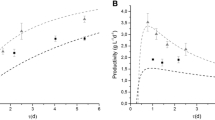Abstract
A two-dimensional model for substrate transfer and biodegradation in a novel, annular fiber-illuminating bioreactor (AFIBR) is proposed in which photosynthetic bacteria are immobilized on the surface of a side-glowing optical fiber to form a stable biofilm. When excited by light, the desired intensity and uniform light distribution can be obtained within the biofilm zone in bioreactor and then realize continuous hydrogen production. Substrate transfer and biodegradation within the biofilm zone, as well as substrate diffusion and convection within bulk fluid regions are considered simultaneously in this model. The validity of the model is verified experimentally. Based on the model analysis, influences of flow rate and light intensity on the substrate consumption rate and substrate degradation efficiency were investigated. The simulation results show that the optimum operational conditions for the substrate degradation within the AFIBR are: flow rate 100 ml h−1 and light intensity 14.6 μmol photons m−2 s−1.








Similar content being viewed by others
References
Bai MD, Cao YC, Lin YH, Lu WC, Lee HT (2009) Immobilized biofilm used as seeding source in batch biohydrogen fermentation. Renew Energy 34:1969–1972
Haluk B, Abdurrahman T (1998) The effects of biofilm characteristics on the external mass transfer coefficient in a differential fluidized bed biofilm reactor. Biochem Eng J 1:53–61
Kaviany M (1995) Principles of heat transfer in porous media. Springer, New York
Kumar N, Das D (2001) Continuous hydrogen production by immobilized Enterobacter cloacae IIT-BT 08 using lignocellulosic materials as solid matrices. Enzyme Microb Technol 29:280–287
Levin DB, Pitt L, Love M (2004) Biohydrogen production: prospects and limitations to practical application. Int J Hydrogen Energy 29:173–185
Liao Q, Wang YZ, Zhu X, Tian X, Ba SL, Zhang P, Zhang C (2008) Effect of initial substrate concentration on kinetics of hydrogen production by photosynthetic bacteria in batch culture. China Biotechnol 27:51–56
Mizuno O, Dinsdale R, Hawkes FR, Hawkes DL, Noike T (2000) Enhancement of hydrogen production from glucose by nitrogen gas spraying. Bioresour Technol 73:59–65
Mowla D, Ahmadi M (2007) Theoretical and experimental investigation of biodegradation of hydrocarbon polluted water in a three phase fluidized-bed bioreactor with PVC biofilm support. Biochem Eng J 36:147–156
Patankar SV, Baliga BR (1981) Numerical heat transfer and fluid flow. Hemisphere, Washington
Shi XY, Yu HQ (2006) Continuous production of hydrogen from mixed volatile fatty acids with Rhodopseudomonas capsulate. Int J Hydrogen Energy 31:1641–1647
Tian X, Liao Q, Liu W, Wang YZ, Zhu X, Li J, Wang H (2009) Photo-hydrogen production rate of a PVA-boric acid gel granule containing immobilized photosynthetic bacteria cells. Int J Hydrogen Energy 34:4708–4717
Vinod AV, Reddy GV (2006) Mass transfer correlation for phenol biodegradation in a fluidized bed bioreactor. J Hazard Mater 136:727–734
Wang YZ, Liao Q, Zhu X, Tian X, Zhang C (2010) Characteristics of hydrogen production and substrate consumption of Rhodopseudomonas palustris CQK 01 in an immobilized-cell photobioreactor. Bioresour Technol 101:4034–4041
Wang YZ, Liao Q, Zhu X, Li J, Lee DJ (2011) Effect of culture conditions on kinetics of hydrogen production by photosynthetic bacteria in batch culture. Int J Hydrogen Energy 36:14004–14013
Zhang C, Zhu X, Liao Q, Wang YZ, Li J, Ding YD, Wang H (2010) Performance of a groove-type photobioreactor for hydrogen production by immobilized photosynthetic bacteria. Int J Hydrogen Energy 35:5284–5292
Acknowledgments
The authors gratefully acknowledge financial support from the National Natural Science Foundation of China (No. 50976029), National High Technology Research and Development Program (863 Program) (No. 2012AA051502), China Postdoctoral Science Foundation (No. 2012M521395), Science and Technology Research Project of Education Department in Henan Province (No. 13B470119) and Doctoral Foundation of NCWU (No. 201028).
Author information
Authors and Affiliations
Corresponding author
Rights and permissions
About this article
Cite this article
Zhang, C., Wang, AJ. & Zhang, QG. A two-dimensional mass transfer model for an annular bioreactor using immobilized photosynthetic bacteria for hydrogen production. Biotechnol Lett 35, 1579–1587 (2013). https://doi.org/10.1007/s10529-013-1250-2
Received:
Accepted:
Published:
Issue Date:
DOI: https://doi.org/10.1007/s10529-013-1250-2




